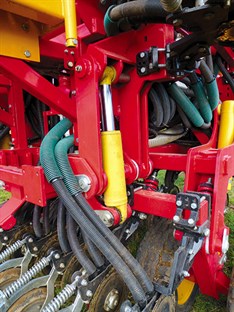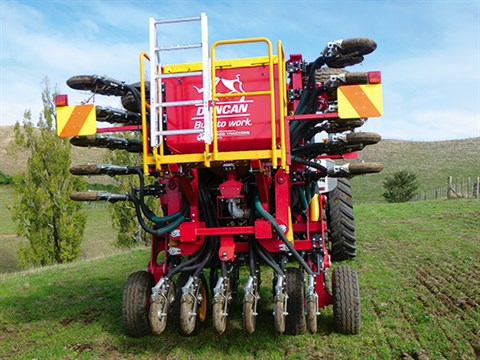Duncan Ag drills: DD30 and DDC45
 The wings on the DDC45 fold to give the machine a 3.1m transport width, although the widest point is up quite high so the machine will sneak through narrow gateways.
The wings on the DDC45 fold to give the machine a 3.1m transport width, although the widest point is up quite high so the machine will sneak through narrow gateways.

 A scalloped disc leads the opposing plain disc to open a slot and create tilth for the seed.
A scalloped disc leads the opposing plain disc to open a slot and create tilth for the seed.

 Hydraulic rams on the transport wheels are also used to control the depth of the drill with shims and a handy guide.
Hydraulic rams on the transport wheels are also used to control the depth of the drill with shims and a handy guide.

 Metering units are used on the bottom of each hopper, for accurate and reliable seed metering.
Metering units are used on the bottom of each hopper, for accurate and reliable seed metering.

 Two massive 1200L hoppers on the drill will minimise downtime and keep the drill operating for a long time between fills.
Two massive 1200L hoppers on the drill will minimise downtime and keep the drill operating for a long time between fills.

 An RDS control box in the cab was easy to see and easy to operate. A seperate screen beside it displays images from the three cameras on the drill.
An RDS control box in the cab was easy to see and easy to operate. A seperate screen beside it displays images from the three cameras on the drill.

 A two-point linkage hitch setup uses two hefty pivot points, allowing for tight turns and the drill to follow undulating contours.
A two-point linkage hitch setup uses two hefty pivot points, allowing for tight turns and the drill to follow undulating contours.

 Hefty hydraulic rams fold the wings for transport and feature accumulators that allow the wings to float while maintaining downward pressure.
Hefty hydraulic rams fold the wings for transport and feature accumulators that allow the wings to float while maintaining downward pressure.


|
|
The wings on the DDC45 fold to give the machine a 3.1m transport width, although the widest point is up quite high so the machine will sneak through narrow gateways.
|

|
|
A scalloped disc leads the opposing plain disc to open a slot and create tilth for the seed.
|

|
|
Hydraulic rams on the transport wheels are also used to control the depth of the drill with shims and a handy guide.
|

|
|
Metering units are used on the bottom of each hopper, for accurate and reliable seed metering.
|

|
|
Two massive 1200L hoppers on the drill will minimise downtime and keep the drill operating for a long time between fills.
|

|
|
An RDS control box in the cab was easy to see and easy to operate. A seperate screen beside it displays images from the three cameras on the drill.
|

|
|
A two-point linkage hitch setup uses two hefty pivot points, allowing for tight turns and the drill to follow undulating contours.
|

|
|
Hefty hydraulic rams fold the wings for transport and feature accumulators that allow the wings to float while maintaining downward pressure.
|
Brent Lilley travels around the North Island, meeting the owners of two different Kiwi-made Duncan Ag drills – the DD30 and the DDC45 – and putting the drills to the test.
When it comes down to the best types of drills, there will be situations where tines are better suited than discs and vice versa. So, in the interests of you, the reader, I caught up with the owners of both disc and tine drills that were also keen to show me why their drill is perfect for them.
Grant Thompson, North Island area manager for Duncan Ag, came along for the ride and pointed out the finer features of each setup.
Double disc drills
First stop was Tirau to catch up with Bernie Trumper, owner of Trumper Contracting Ltd. I was in for a treat when I got there, as he had not only a standard DD30 double disc drill from Duncan Ag, but also a recently commissioned DDC45, which is the 4.5-metre version of the DD30.
Design
While both drills where largely built on the same principles as an air seeder with double disc openers, and both have largely the same features, it was the large DDC45 that I chose to concentrate on.
As with any machine over three metres wide, the construction gets a bit tricky and on the DDC45. Duncan Ag has used folding wings on either side of the machine to give an overall sowing width of 4.8 metres but has kept the travel width when folded to 3.1 metres.

These wings feature clever hefty hydraulic rams fitted with adjustable accumulators, which allow the wings to float independently and up to five degrees up or down. The wings follow the ground contours, while maintaining a constant down pressure to ensure the coulters are in the ground at all times. Each wing has a wheel among the coulters that also helps with ground following.
Hydraulic rams on the wheels are used to lift the openers out of the ground at the end of a run and shims on the rams are used to set the working depth. Wheels under the fixed centre section of the drill work on the same principle of those on the wings, but there are four of them with 10.0/75 — 15.3 tyres on to take the weight for transport.
At the front of the drill is a hitch setup that uses a two-point linkage system to mount to the link arms of the tractor, allowing movement in undulating conditions. The drawbar of the drill mounts to this hitch with a hefty greasable 50mm pin, allowing plenty of clearance for tight turns.
Disc openers
The disc openers on the DD range use two discs, one scalloped and one plain, in a V formation to open a slot for the seed. Both are mounted on triple-sealed bearings to keep maintenance requirements low. The clever part is that a scalloped disc slightly leads the second plain disc, which helps the openers penetrate the ground and creates a small amount of tilth without disturbing too much of the surface.
A large adjustable coil spring at the front of the openers ensures the weight of the machine is transferred to them, with over 100kg of downward pressure on each one to keep it in the ground. This setup also allows for over a 100mm of travel up or down from the centre point, so each opener follows the contour of the ground independently.
Thirty-two openers are spaced in two rows across the width of this machine to give a 150mm, or six-inch, row spacing, although I'm told they are also able to be produced in a 125mm row spacing setup.
A rubber press wheel closes the slot and firms the soil around the seed to ensure good contact and speeds up the germination process. An adjustable spring on the press wheels can be used to change the downward pressure to suit the conditions.
Hopper
Two large hoppers sit up on top of the machine, with a massive 1200-litre capacity in both the front and rear bins to minimise down time and keep you drilling.
The sides of the hoppers feature cut-outs for the folding wings, keeping the overall width of the machine down for transport. Separate access platforms at the front and back of the drill have sturdy ladders and handrails for safety.
Distribution heads are cleverly hidden inside each bin, which keeps the appearance of the drill tidy and keeps them out of the weather. Separate cameras mounted in each bin make it easy for the operator to keep an eye on how the seed is running from the cab of the tractor without stopping.
Metering and calibration
The metering systems used by Duncan Ag are sourced from a European manufacturer. These units offer a simple, reliable mechanism with well-proven results.
Electronic motors use a ground-speed radar to accurately drive the metering units at the correct speed. This also makes calibration incredibly simple. Simply open the flap under the metering unit, set it to measure out one kilo on the control box, catch and weigh the seed and then enter the weight into the control box to calculate and change the speed required to hit the target rate.

Generally, on the second run the drill will be spot-on, so the right amount and the desired sowing rate can be entered into the control box.
The fan is mounted up front and the speed can be varied via the hydraulic flow from the tractor. A butterfly valve, where the airflow splits to the two metering units, allows the proportion of air to each unit to be controlled.
Monitor
Up in the cab of the big Fendt 927 that was towing the drill, I found the RDS control box used by Duncan Ag to control the drill simple and easy to use. A display shows all the important information such as speed, sowing rate and area covered. Buttons down the side of the screen are used to access page style menus, calibration, and previous store information, as well as factory settings. A numeral keypad on the box also makes it easy to input sowing rates.
Verdict
As mentioned, seeing New Zealand-built machines that can hold their own against anything from overseas really impresses me and the Duncan DDC45 definitely delivers.
They have stuck with simple, reliable, and well-proven concepts from the DD30 combined with a wing float system that follows the contours to build this larger model drill and ensures it does just as good a job as the DD30.
The double disc setup with press wheels was a real winner in this situation, creating a perfect environment for seed to flourish. The metering system and the electronic drive really take the hassle out of set up and operation.
Duncan DDC45 drill pros
- Economical double disc setup
- Accurate electronic drive system
- Press wheels ensure a firm seed bed
- Simple robust and effective design
- Distribution heads cleverly hidden inside the hopper
Cons
- Separate access platforms to climb up to for each hopper
For the latest reviews of farm machinery, subscribe to Farm Trader magazine here.
Keep up to date in the industry by signing up to Farm Trader's free newsletter or liking us on Facebook


.jpeg)








.jpg)
.jpg)
.jpg)

